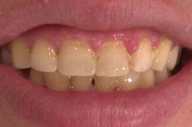Tuberous sclerosis complex (Bourneville disease)
Published Web Location
https://doi.org/10.5070/D38q09k4g3Main Content
Tuberous sclerosis complex (Bourneville disease)
Christopher T Cassetty MD
Dermatology Online Journal 10 (3): 17
From the Ronald O. Perelman Department of Dermatology, New York University
Abstract
A 26-year-old woman with tuberous sclerosis complex had numerous cutaneous manifestations and systemic manifestations that included subependymal nodules, pulmonary lymphangioleiomyomatosis, renal cysts, and bilateral renal angiomyolipomas. Tuberous sclerosis is a hamartomatous disease with defects in either hamartin (TSC1) or tuberin (TSC2) that can be of autosomal dominant inheritance or spontaneous mutation.
Clinical synopsis
History.—A 26-year-old woman presented with a 20-year history of oral and cutaneous findings. Within the first year of life, the patient experienced spasms that required anti-epileptic medication until age 5. During childhood, she developed a variety of cutaneous lesions on her face and lower extremities. She also had subependymal nodules and cortical tubers on a computed-tomography scan of her brain. In her teenage years she developed depression that resolved with treatment. Since childhood she has had difficulty breathing with strenuous exertion. In 2001, she developed a pneumothorax, and the evaluation resulted in the discovery of pulmonary lymphangioleiomyomatosis. She enrolled in a National Institutes of Health study in September 2003. In October 2003, the patient presented to Tisch Hospital at the New York University Medical Center for an elective angioembolization of bilateral renal angiomyolipomas.
The patient receives depo-medroxyprogesterone acetate injections for uterine fibroids, omeprazole for gastro-esophageal reflux disease, and ipratropium bromide and albuterol sulfate inhalation aerosol for shortness of breath. She denies ocular or cardiac involvement. There is no family history of similar signs or symptoms.

|

|
| Figure 1 | Figure 2 |
|---|

|
| Figure 3 |
|---|
Physical examination.—Centrofacial, red, 0.1-0.3-cm, exophytic papules and plaques were present on the nose and paranasal areas of the cheeks. Skin-colored, firm, papillated plaques were present on the forehead. Pink plaques with an uneven surface were present on the left cheek. Erythematous, gingival papules were present along the interdental prominences. Numerous, tiny pits were noted in the dental enamel. Numerous, confetti, hypopigmented macules were present on the lower extremeties. Periungual, skin-colored-to-pink, 0.1-0.2-cm papules were present on the left third finger and right fifth toe.

|

|
| Figure 4 | Figure 5 |
|---|---|
| Figure 4: Brain, magnetic-resonance imaging: T-1 right ventricle subependymal nodule | |
| Figure 5: Abdomen, computed-tomography (noncontrast): Left kidney mass (angiomyolipoma) | |
Diagnosis.—Tuberous sclerosis complex (Bourneville disease).
Comment
Tuberous sclerosis complex is a hamartomatous disease that affects the skin and internal organs. Cutaneous manifestations include angiofibromas, fibrous plaques, collagenomas (shagreen patches), periungual fibromas (Koenen tumors), gingival fibromas, dental enamel pits, hypopigmented macules (ash-leaf and confetti), and cafè-au-lait macules. Internal organs that may be involved include the retina, brain (calcified subependymal nodules, cortical tubers, giant cell astrocytomas, and cerebral white matter radial migration lines), heart (cardiac rhabdomyomas and arrhythmias particularly Wolf-Parkinson-White syndrome), lung (pulmonary lymphangioleiomyomatosis), kidney (renal cyst, renal angiomyolipomas, and rarely renal-cell carcinomas), and other organs (gastrointestinal tract and uterus). Often patients have neurologic deficits that include seizure disorders and mental retardation. [1] The diagnosis is mainly clinical, with neuroradiographic imaging based on the diagnostic criteria of major and/or minor features. [2]
| Major features |
|---|
|
| Minor features |
|
| Definite tuberous sclerosis complex |
|
| Probable tuberous sclerosis complex |
|
| Possible tuberous sclerosis complex |
|
| Roach ES, et al. Tuberous sclerosis consensus conference: revised clinical diagnostic criteria. J Child Neurol 1998; 13: 624 |
The incidence of tuberous sclerosis complex is estimated at 1/10,000. Two thirds of cases are thought to be sporadic, while the other one third is autosomal dominantly inherited. [3] Two genes are involved in tuberous sclerosis complex, which functions as a cytoplasmic protein complex. This complex is thought to have inhibitory effects on cell growth, cell proliferation, intracellular trafficking, cell adhesion, and cell migration. [3, 4] The genes are hamartin (TSC1), which is located on chromosome 9q34, and tuberin (TSC2), which is located on chromosome 16p13.3 adjacent to the gene for polycystic kidney disease. A contiguous gene syndrome was identified in patients with tuberous sclerosis complex and polycystic kidney disease. [5] Genetic testing is available.
Histopathology of the angiofibromas includes dermal fibrosis and dilatation of the blood vessels with occasional multinucleated giant cells. Shagreen patches may resemble morphea with broad collagen in a sclerotic dermis, although it can also appear as normal collagen bundles interlacing through the dermis. The hypopigmented macules have normal numbers of melanocytes but decreased melanin. [6]
Management should be coordinated between multiple specialties with periodic imaging assessments and symptomatic treatment. Assessments include brain computed tomography or magnetic resonance imaging, electroencephalogram, retinal evaluation, skin examination, renal ultrasound, electrocardiogram, echocardiogram, and neurodevelopmental assessments. Cutaneous manifestations are often of cosmetic concern and typically can be managed by excision, dermabrasion, and lasers.
References
1. Jozwiak S, et al. Skin lesions in children with tuberous sclerosis complex: their prevalence, natural course and diagnostic significance. Int J Dermatol 1998; 37: 911.2. Roach ES, et al. Tuberous sclerosis consensus conference: revised clinical diagnostic criteria. J Child Neurol 1998; 13: 624.
3. Narayanan V. Tuberous sclerosis complex: genetics to pathogenesis. Pediatr Neurol 2003; 29: 404.
4. Birchenall-Roberts MC, et al. Tuberous sclerosis complex 2 gene product interacts with human SMAD proteins: a molecular link of two tumor suppressor pathways. J Biol Chem 2004 Apr 2 [Epub ahead of print].
5. Laass MW, et al. Tuberous sclerosis and polycystic kidney disease in a 3-month-old infant. Pediatr Nephrol 2004 Mar 9 [Epub ahead of print].
6. Heenan PJ. Tumors of the fibrous tissue involving the skin. In: Elder D, et al, Eds. Lever's Histopathology of the Skin. Eighth edition. Philadelphia: Lippincott Williams & Wilkins, 1997: 847.
© 2004 Dermatology Online Journal

